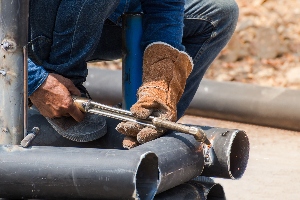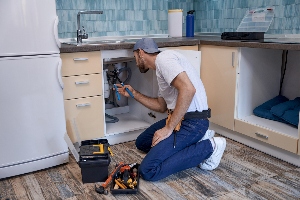Hydro jet plumbing is a powerful and efficient method for maintaining your home's plumbing system. It involves the use of high-pressure water jets to clear away clogs and build-up inside pipes. This technology is effective in removing stubborn blockages that traditional methods, such as plunging or chemical cleaners, can't resolve. By using hydro jetting, you ensure that your plumbing lines are thoroughly cleaned, which can help prevent future issues related to clogs.
This process is best performed by professionals, as it requires specialized equipment including a high-pressure hose and a water jetting machine. The high-velocity water streams scours the interior surfaces of the pipes, removing debris like grease, mineral scale, and other deposits from the pipe walls. Regular maintenance using hydro jetting can extend the life of your plumbing system and prevent the inconvenience of unexpected blockages.
Basics of Residential Hydro Jet Plumbing
Hydro jetting is a powerful solution for maintaining and cleaning your home's plumbing system. It harnesses the force of water to effectively clear blockages and buildup.
What Is Hydro Jetting?
Hydro jetting is a cleaning method which involves blasting water at high pressure through your plumbing pipes. This water stream is strong enough to break down and remove common blockages such as roots, grease, and mineral deposits.
Benefits of Hydro Jetting
- Effectiveness: Hygienically cleans pipes without the use of harsh chemicals.
- Efficiency: Clears blockages more thoroughly compared to traditional methods like snaking.
- Preventative Care: Regular hydro jetting can help prevent future clogs by removing residue before it accumulates.
Common Applications
- Drain Maintenance: Regularly used to clear kitchen, bathroom, and other residential drains.
- Sewer Line Cleaning: Effective for removing tree root infiltrations and cleaning sewer lateral lines.
- Resolution of Persistent Clogs: Ideal for addressing clogs that cannot be resolved through plunging or snaking.
The Hydro Jetting Process
The hydro jetting process is a precise procedure involving initial inspections and the utilization of high-pressure water jets to effectively clear blockages within your plumbing system.
Assessment of Blockages
Before hydro jetting can commence, your plumber needs to identify the exact location and severity of the blockage in your pipes. This may involve using specialized camera equipment to visually inspect the interior of your plumbing and pinpoint blockage sites.
Pre-cleaning Inspections
A thorough inspection is critical to ensure that your pipes are in a suitable condition for hydro jetting. This step involves assessing the structural integrity of your plumbing to prevent damage from the high-pressure water. It’s essential to confirm that your pipes can withstand the pressure to avoid potential complications.
Operation of Hydro Jetting Equipment
- Preparation: Your plumber will set up the hydro jetting machine, which consists of a water tank, high-pressure hose, and nozzle.
- Procedure: The nozzle is inserted into the drainage point, and water is blasted through the pipes at high pressure. This water stream can reach up to 35,000 psi, depending on the situation.
- Efficacy: The water scours the pipe walls, removing grease, debris, and scale build-up, and flushes them out, leaving your pipes clean and clear.
Equipment and Tools
When tackling residential hydro jet plumbing, you need to understand the specific equipment and tools involved. These are critical to effectively clearing out your pipes without causing damage.
Types of Hydro Jets
Hydro jets come in various types, each suited for different plumbing scenarios:
- Portable Hydro Jets: Ideal for small residential jobs, easily transportable.
- Truck-Mounted Hydro Jets: More power and water volume, suitable for extensive blockages and larger pipelines.
Safety Equipment
To ensure your safety during hydro jetting:
- Eye Protection: To protect your eyes from any debris.
- Gloves: Durable gloves to guard your hands against high-pressure water streams.
Nozzles and Accessories
Nozzles and accessories enhance the versatility and effectiveness of hydro jet machines:
- Standard Nozzles: For general pipe cleaning and clog removal.
- Specialized Nozzles: Designed for cutting through stubborn build-up or tree roots.
- Hoses: Varying in length and diameter to accommodate different pipe sizes.
Safety and Precautions
Ensuring safety during hydro jetting is critical due to the high pressures involved. Your awareness of hazards and proper safety protocols protects both individuals and property.
Handling High-Pressure Water
The core of hydro jetting involves water pressures that can exceed 4,000 PSI. Mishandling this force can lead to injuries or even fatalities. When operating, never point the jet nozzle at yourself or others, and always ensure the hose is firmly attached to the pump. Inspect equipment regularly to prevent malfunctions that could pose risks.
Protective Measures for Technicians
Technicians must wear Personal Protective Equipment (PPE), including:
- Safety goggles to protect eyes from flying debris.
- Waterproof gloves and boots to reduce the risk of slips and to maintain grip.
- Ear protection to shield from high noise levels of the machinery.
High-pressure water can cause serious injuries, so full body coverage is recommended.
Preventing Property Damage
Hydro jetting is powerful enough to damage property if not used correctly. Protect vulnerable areas by:
- Covering nearby items with tarpaulins.
- Securing loose fittings and fixtures before starting.
- Avoiding direct spraying on fragile pipes to prevent breakage.
Ensure the correct nozzle is selected for the pipe size and material to minimize the chance of pipe erosion or damage.
Maintenance and Care
Proper maintenance and care of your hydro jet plumbing system are crucial for long-term efficiency and preventing unnecessary repairs. Follow these guidelines to keep your system in top condition.
Routine Maintenance Tips
- Inspect your drains regularly for signs of slow drainage, which might indicate buildup.
- Reduce Issues by avoiding the disposal of grease, large food particles, and non-flushable items down your pipes.
- Flush Drains with hot water weekly to help prevent buildup.
Troubleshooting Common Issues
- Slow Drains may just require a simple plunger action. If that doesn't work, check for visible blockages near the drain opening.
- For Recurring Clogs, a DIY enzymatic cleaner might help maintain the drain but is not a substitute for professional cleaning.
When to Call a Professional
- If you experience Persistent Clogs that resist all your efforts, it's time to consult a professional.
- Should you notice Multiple Blocked Drains or hear gurgling sounds, a professional should assess your system for potential deeper blockages or systemic issues.












